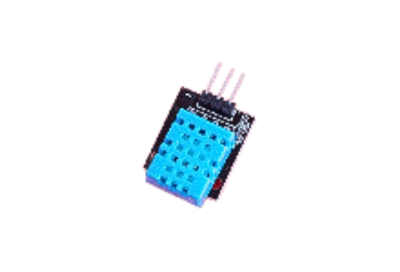What Is a Humidity and Temperature Sensor?
 A humidity and temperature sensor is a device used to measure temperature and humidity.
A humidity and temperature sensor is a device used to measure temperature and humidity.
Since a single unit can measure both temperature and humidity, it requires little installation time and space.
Uses of Humidity and Temperature Sensors
Humidity and temperature sensors are used to measure temperature and humidity, and are used, for example, in the following fields:
- Measurement of outside temperature and humidity
- Sensors for air conditioning equipment, such as air conditioners and heaters
- Sensors to manage automobile engines
- Sensors in smartphones, computers, etc.
Industrial inspections
Principle of Humidity and Temperature Sensors
Humidity and temperature sensors are composed of a temperature sensor and a humidity sensor. Temperature sensors are broadly classified into three types: resistance temperature detectors (RTDs), linear resistors, and thermistors, while humidity sensors are broadly classified into two types: resistance change type and capacitance change type. They are explained in the following order.
1. Temperature Sensors
Resistance Thermometer (RTD)
Resistance thermometer (RTD) is a type of temperature sensor that measures electrical resistance to determine temperature. RTDs utilize the property of electrical resistance of metals such as platinum, nickel, and copper, metal oxides, and semiconductors to increase with rising temperature, and measure temperature by measuring the electrical resistance value.
Linear Resistors
Linear resistors are temperature measuring resistors made of nickel-nickel or palladium alloys and utilize the property that resistance increases almost linearly with temperature. They are not as accurate as resistance thermometers made of platinum or other metals.
Thermistors
Thermistors are elements whose resistance changes with temperature. Temperature sensors use thermistors to measure the temperature by utilizing the correlation between the temperature and resistance of the element. There are two types of thermistors: PTC thermistors (positive characteristic), whose resistance increases with increasing temperature, and NTC thermistors (negative characteristic), whose resistance decreases with increasing temperature.
PCT thermistors are characterized by a sharp rise in resistance at a certain temperature and are suitable for overcurrent protection in the event of a semiconductor thermal runaway. NCT thermistors, on the other hand, have a high resistance at room temperature and a large change in resistance as the temperature rises. Therefore, they are generally used for circuit protection at temperature. The term “thermistor” usually refers to NCT thermistors.
2. Humidity Sensor
Resistance Change Type
Resistance change type temperature sensors are sensors that derive humidity from changes in resistance. They are characterized by a structure in which the comb teeth of the comb-shaped circuit built into the sensor are bridged by a moisture-sensitive membrane made of polymer.
When humidity rises and the humidity-sensitive film absorbs moisture, the resistance of the humidity-sensitive film decreases due to the increase of mobile ions in the film, and conversely, when humidity falls, the resistance increases. In other words, in resistance change type temperature sensors, humidity is derived from the change in resistance value.
Capacitance Type
Capacitance-type temperature sensors convert changes in capacitance into humidity, and are characterized by a humidity-sensitive membrane made of polymer sandwiched between two electrodes. As the humidity increases, the capacitance between the electrodes will increase due to the increase of mobile ions in the moisture-sensitive membrane.
On the other hand, when humidity decreases, the capacitance between the electrodes decreases because the number of movable ions in the humidity-sensitive membrane decreases. In other words, a capacitance-type temperature sensor converts changes in capacitance into humidity.
Types of Humidity and Temperature Sensors
Humidity and temperature sensors are classified by shape, and include IC type humidity sensors embedded in IC chips and wireless type humidity sensors used in the Internet of Things (IoT).
1. IC Type Humidity and Temperature Sensor
IC-type humidity and temperature sensors consist of a sensor element and a measurement circuit, such as A/D converter integrated into a single chip. When using individual sensor elements, it is necessary to design the peripheral circuits according to the application, which is time-consuming and costly.
However, the integrated IC type humidity and temperature sensor does not require such time and effort and can be used easily. In addition, the mounting area required for mounting on a board can be reduced, enabling miniaturization, low power consumption, and low cost.
2. Wireless Humidity and Temperature Sensor
In recent years, not only PCs and smartphones but also various other devices have become connected to the Internet. This so-called IoT (Internet of Things) technology enables information exchange between devices, remote control, and data collection, and is used in a variety of services.
The role of sensors is especially important in services and systems that remotely monitor the status of goods and detect abnormalities. Therefore, sensors that transmit data via wireless communication means such as Wi-Fi and Bluetooth, known as IoT sensors, are emerging.
Wireless humidity and temperature sensors are one of these sensors. By utilizing wireless humidity and temperature sensors, systems can be built to check and monitor temperature and humidity at remote locations. Specifically, they are used for temperature/humidity control and abnormality detection in places where people are not always present or visible, such as data centers, production lines, cooling facilities, warehouses, and greenhouses.
In addition, the system is used in a variety of applications and situations, such as window and door open/close detection, sensors to detect the movement of people and animals, home security services linked to home appliances, and monitoring services for the elderly.